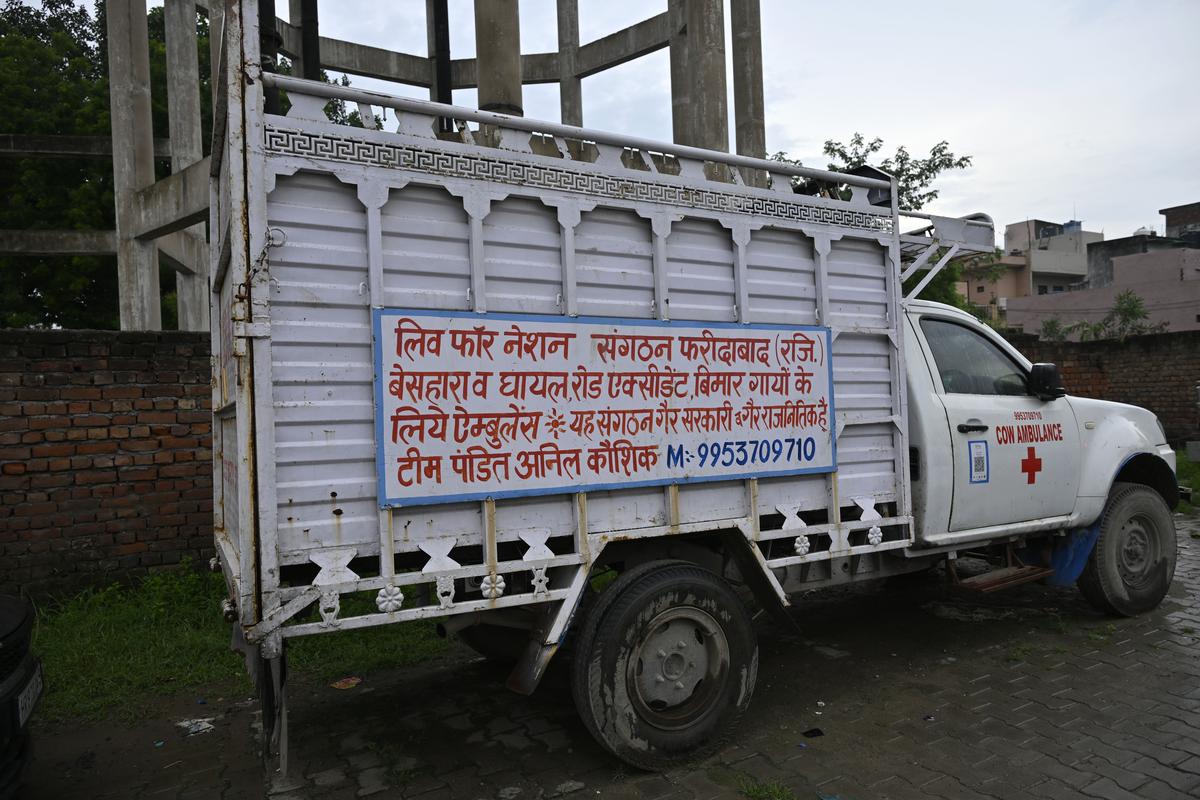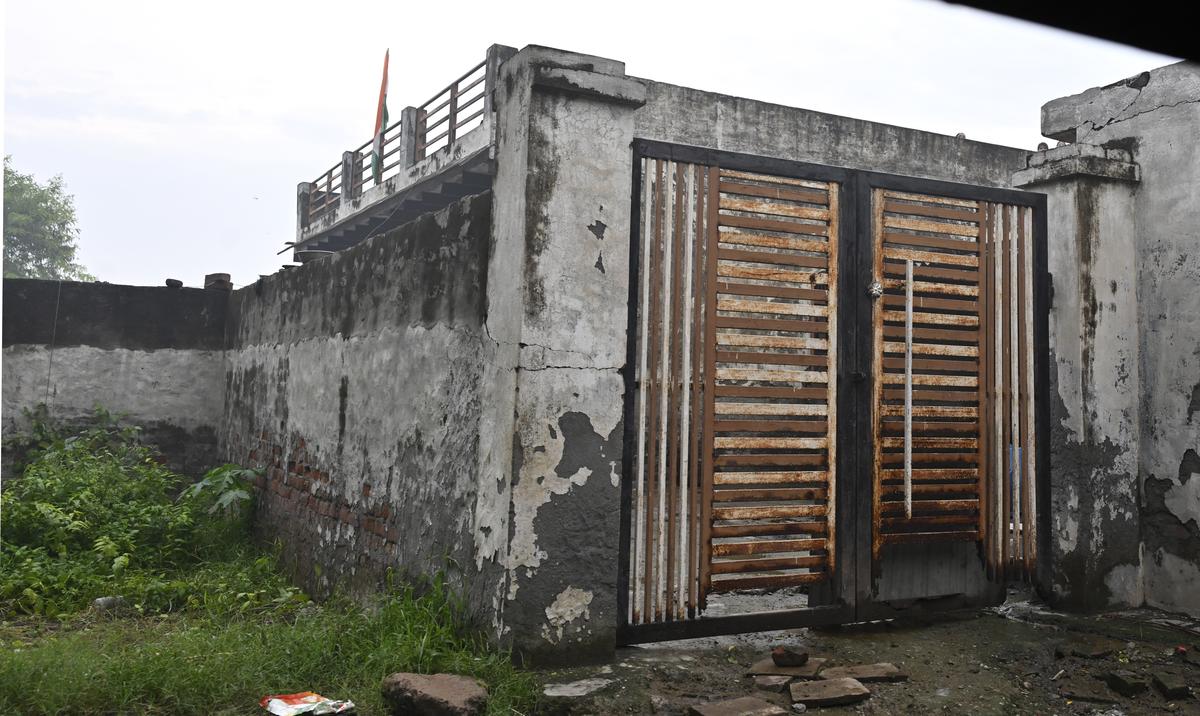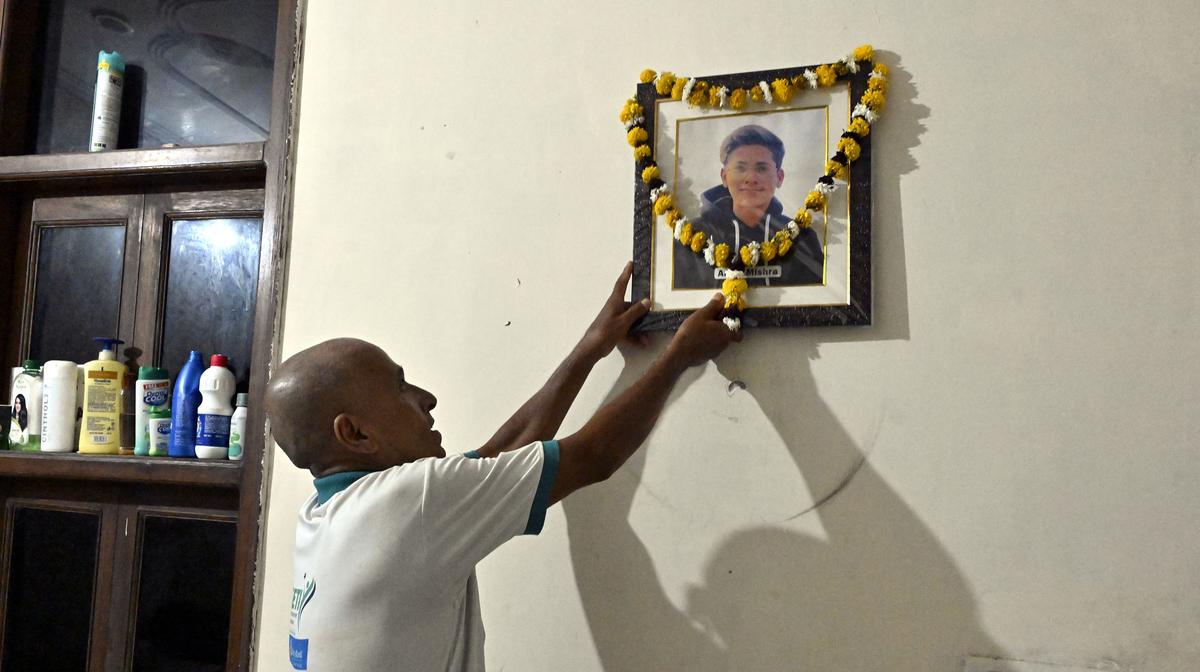While the New Industrial Township (NIT-5) market in Faridabad, Haryana, is lit up brightly, a house on the fourth floor of a building in the area lies in darkness. Here, a family mourns the death of their son, Aryan Mishra, who was shot dead on August 23. A poster hangs from the partially painted terrace of the building, just metres below an Indian flag. It features a picture of Aryan, 20, wearing a hoodie and a smile, and seeks justice for him.
On August 23, Aryan was travelling in a red SUV with the Gulatis, the owners of the house in which his family lives, after enjoying a late-night snack. According to the police, five men, most of them in their 20s, allegedly mistook Aryan to be a cattle smuggler and chased the car for 30 kilometres before firing at him.
All the five ‘gau rakshaks’ (cow vigilantes) belong to an organisation called Live For Nation (LFN), which had been formed with the sole aim of “saving cows”. The police scanned CCTV camera footage, tracked mobile phones, and interrogated people on the 30-km stretch for five days to collect evidence of the crime. On August 28, they arrested all the five men for Aryan’s murder: the founder of LFN, 38-year-old Anil Kaushik, and his aides, Saurabh, Kishan, Varun, and Adesh.
Siyanand Mishra, Aryan’s father, is shattered that his “youngest and brightest child” is dead. He says his son was pursuing an intermediate course through the open schooling system, while also helping the family financially by repairing mobile phones and riding bike taxis around Faridabad, an industrial city about 35 km from Delhi.
Mishra says he met one of the accused on the day the police were set to open the case. “He was ashamed of his act since he had killed his Hindu brother mistakenly,” he says. While Mishra has all kinds of theories about why his son was killed, the police are still investigating the case.
Protecting cows
The murder of Aryan Mishra has once again brought attention to India’s cow vigilante groups, who claim to protect cows, considered holy by Hindus, from alleged smuggling and slaughter. The Haryana Gauvansh Sanrakshan and Gausamvardhan Act, 2015, prohibits the slaughter and trafficking of cows and sale of beef in the State. Anyone found to be violating this can be imprisoned for up to 10 years. However, the killing of other cattle, such as buffaloes, is legal.
Days after Aryan was killed, a migrant worker from West Bengal was killed by alleged cow vigilantes in Haryana’s Charkhi Dadri on suspicion of eating beef. Last year, a cow vigilante, Monu Manesar, from Haryana, was booked for the murder of two men. Manesar is a member of the Bajrang Dal, the youth wing of the Hindu right-wing organisation, Vishwa Hindu Parishad (VHP).
To protect cows, Haryana, where the Bharatiya Janata Party has been in power for the last 10 years, has increased the budget of the Gau Seva Aayog, a force under the government dedicated to the preservation and welfare of cows, from ₹45 crore in 2022-23 to ₹456 crore in 2023-24. As of August 2024, the State had provided ₹32.16 crore to 588 gau shalas (shelters for stray cows), which house 23.5 lakh cows.
The founder of ‘Live For Nation’
The main accused in the Aryan murder case, Anil Kaushik, lives in a double-storey house in Parvatiya colony, some 7.5 km from NIT-5 market. A picture of the Hindu god, Hanuman, hangs outside his house.
Kaushik, a gold medallist from Rohtak University who holds a Master’s degree in Business Administration, lost his job during the COVID-19 pandemic, says his brother, Sunil.

The unemployment rate in Haryana’s urban and rural areas in the 15-29 age group in 2022-23 was 17.5% compared to the national average of 10%, according to the annual Periodic Labour Force Survey, conducted by the government. The extent of the problem in the State can be gauged from the fact that more than 1.2 lakh people, including 46,000 graduates and postgraduates, have applied for contractual jobs of sweepers under the Haryana Kaushal Rozgar Nigam just this month. This agency was set up with the objective of providing manpower to all government entities in Haryana.
Kaushik has multiple Facebook accounts. One of them has more than 10,000 followers, while others have fewer. Mostly dressed in T-shirts and jeans, Kaushik sports a ponytail, wears a tilak (Hindu mark) on his forehead, and roli or red threads around his wrist.
He regularly posted videos in which he can be seen rescuing cows from drains, tying reflective collars on them, or giving them first aid. He would also chase vehicles of alleged cow smugglers at night on highways. The videos of these chases have garnered the highest number of likes and views on his page. In one photo, Kaushik can be seen holding a gun. In others, he can be seen posing with policemen, advocates, and Monu Manesar. In a Facebook live, Kaushik reprimanded critics of gau rakshaks: “Kabhi aa ke dekhlo humare saath…Jab goli bagal se nikalti hai…to kaisa lagta hai [Come sometime and watch with us…how it feels when a bullet (from the alleged cattle smugglers) passes so close].”
On social media, Kaushik posted the account number of LFN and often sought donations. In the markets in and around Parvatiya colony, many shops have a LFN donation box.

Kaushik’s mother, Rajesh Devi, has been angry ever since her son was arrested. “Please leave us alone,” she says, shutting the door. Speaking to a television channel earlier, she had said that her son had mistaken Aryan for a cow smuggler and could “never kill anyone who was innocent”.
Sunil says the family is struggling to cope with two tragedies: first, the death of his wife, who had been suffering from an illness, and now his older brother’s arrest.
He believes that critics of gau rakshaks are hypocritical. “In today’s time, if you love a dog, you are respected in society; if you pet a cat, you are dubbed an animal lover; but if you love a cow, people treat you like a criminal,” he says, ignoring the death.
Sunil’s neighbour, Hawa Singh Rathi, wonders why Kaushik had never kept a cow as a pet if he really wanted to save cattle.
‘A well respected organisation’
Next to Kaushik’s house lies a ground with cemented benches, tall trees, mounds of garbage, and dilapidated rooms. Stray animals, including cows, share this space. Kaushik had parked a pickup van here, which the LFN used at times to ferry injured cattle to hospital and at times to chase alleged cow smugglers. An SUV stands next to the van with a guard covering the windscreen.

A van which the cow vigilantes use to ferry injured cows to hospital or to chase alleged smugglers.
| Photo Credit:
Sushil Kumar Verma
A kilometre away from Kaushik’s home is his office. A board outside states that he is a gau rakshak and property dealer. A pamphlet pasted on the left wall of the shop’s shutter shows cow dung cups that Kaushik used to sell for havans.
Sushil Kumar, 36, who runs a fabrication shop in Parvatiya colony, calls Kaushik a “gentleman”. Sushil was a member of LNF and used to chase alleged cattle smugglers with Kaushik, but stopped after his father’s death. “The smugglers had arms. Since I was the only earning member after my father’s death, my family asked me not to do this,” he says. “LNF is very popular in the area. The organisation is fighting for Hindus and our members are respected among locals,” he adds.
Bharat Kumar, 28, who runs a photo studio, and Akshay Sharma, 24, who works at a courier service centre, are also members of LNF. They cite the recent achievements of the group: “Kaushik and his team managed to save an injured camel from a place near Anankpur village.”
While Sushil did not finish college, Akshay and Bharat are graduates. They earn ₹10,000-₹15,000 a month. They live in localities with no sanitation. The roads get flooded with sewage water even when it does not rain. The houses, located in narrow lanes, are barely ventilated. The area has poor ground water supply: tankers can be seen parked every 400-500 meters.
Speaking about the modus operandi of gau rakshaks, Bharat says people from all walks of life are connected through social media and post any information about destitute or injured cows. “We also get information from places where cows were seen being put into vehicles to be transported. We react quickly and chase them. We have saved hundreds of cows from dying,” he says.
Speaking of the accused in the Aryan murder case, Sushil says Saurabh was working with a builder, Adesh was an office assistant at a local school, while Varun used to collect samples for pathology. All of them were searching for permanent jobs.
Kishan, the fifth accused, lives in Kheri village, about 6 km from Kaushik’s house. His father, Joge, and four sisters refuse to be identified as his family. Joge is traumatised by the arrest of his son and says he is not able to think or react.

Kishan’s house in Kheri village, Faridabad.
| Photo Credit:
Sushil Kumar Verma
“When he refused to study further, I spent all my savings to open a garment shop for him. All of that has gone in vain,” says Joge, who has a cow and buffalo at home.
The residents of the village say one of Kishan’s sisters was scheduled to get married next month, but the family is thinking of postponing the wedding as they want to first get Kishan out of jail.
Murder, money, and justice
On August 23, Aryan left home in a hurry, recalls Siyanand Mishra, a heart patient. A saffron flag hangs on the main door of his two-room house, taken on lease from the Gulati family at ₹4.5 lakh. Aryan’s photos hang on the wall right in front of the entrance. As the family has been running from pillar to post to seek justice for their son, the house had not been cleaned.

“Aryan told me that Harshit and Shankey Gulati, the sons of my landlord Sujata Gulati, had called him for a quick chat. I told him that he shouldn’t be going anywhere at that time of the night, but he went saying he would return in 10 minutes,” says Mishra.
After Aryan was shot on his head and shoulder, Mishra says he received a call from the Gulatis. He wails recalling the tragic moment: “When I asked Sujata what had happened to Aryan, she said that she, her sons, and one of her friends, Kirti, had gone out to eat late at night and had invited Aryan too. They were on the highway when some people, who have a property-related dispute with her son, Shankey, started firing at them. And Aryan got shot.”

Aryan Mishra’s father, Siyanand Mishra, demands justice for his youngest son, who was shot dead in Faridabad.
| Photo Credit:
Sushil Kumar Verma
Mishra says he and the Gulatis have had an ongoing dispute about lease money. “Who knows? The Gulatis may have been hand in glove with the gau rakshaks,” he says. “Who gave them the right to shoot anyone? They are criminals.”
Mishra’s second son is struggling to take care of his elderly parents. Speaking of his eldest son, who is married with a child and works as a sweeper in a factory, Mishra says, casteism deeply embedded, “He couldn’t get a job. So, even though we are Brahmins, he had to do what we are not supposed to do.”
He locks the door and leaves for the hospital where his wife, Uma, was admitted after she fainted while performing rituals for Aryan.
The Deputy Commissioner of Police (Crime) Faridabad, Hemendra Kumar Meena, says the police are still investigating the case. The picture will become clear when they get custody of the accused for interrogation, he says.
‘Like the job of a solider’
Vikas Sharma, 32, a cow vigilante who lives in Parvatiya colony, is associated with the Bajrang Dal. He feels that the murder of the “Hindu boy” is a blot in the name of gau rakshaks. “The Bajrang Dal protects cows too, but never takes law and order into its hands,” he says.
Sharma’s father was in the Army. Taking pride in being a gau rakshak, he compares it with the job of a soldier. He says Uttar Pradesh Chief Minister Yogi Adiyanath is his favourite politician as he has made the State “a safe place for Hindus”. In 2022, U.P. registered the most number of crimes under the Indian Penal Code across India, according to data of the National Crime Records Bureau.

Sharma applauds the controversial Agnipath scheme of the Modi government, which aims to recruit personnel below officer ranks to the Indian armed forces for a period of four years. “The idea is that within a couple of decades, every house will have a trained soldier. This will save the nation when we are attacked by people from both within and outside,” he says, adding that countries such as Israel have a similar practice.
Sharma does odd jobs to earn money. He says his family has been asking him to get a job, but nothing good has come his way because he lacks proficiency in English. “Can I also become a journalist in your paper,” he asks. I am sure I can at least click pictures for you.”
ishita.mishra@thehindu.co.in
Published – September 07, 2024 04:03 am IST